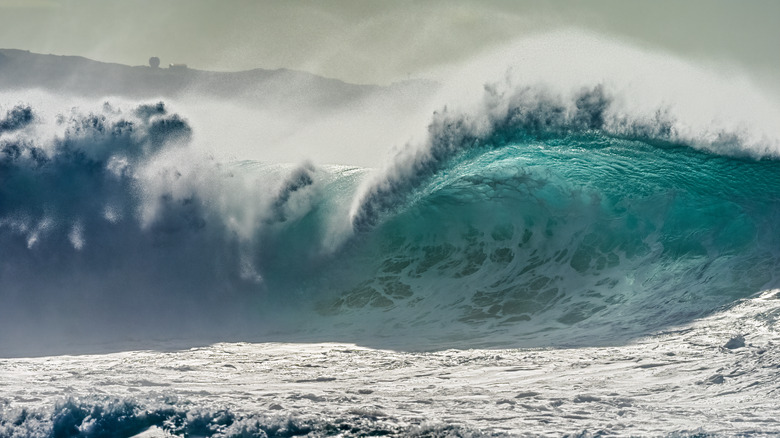This Popular Surfing Spot Is Considered One Of The Deadliest In The World
A sanctified space for Hawaii's surfing community and icing on the cake for riders seeking big-wave surfing, Waimea Bay is an iconic name in the industry. Located on the north shore of Oahu, Waimea caters to those eager to test their skills in the art of surfing, easily producing up to 50-foot waves that barrel over its reef. In summer, the cove is a scene of calm, relaxed water, giving no hint of a fatal surf break. As October and November fade into December, however, winter storms drive in large swells, churning up the water and resulting in consistent sets of monstrous breaks.
Kooks and groms (novice surfers) have no place surfing Waimea's hauntingly dangerous break, and even experienced surfers encounter trouble handling the oversized waves. Waimea Bay is known as one of the top 10 largest surf breaks in the world. Its reputation for producing large, unpredictable swells earned it the honor of hosting the Eddie Aikau Big Wave Invitational. This premier surfing event is a legendary competition among the world's top surfers, who are invited to showcase their talent and celebrate the majesty of the ocean while testing their strength and endurance. Named after iconic surf legend Eddie Aikau, this herald competition doesn't take place every year. Only during winter seasons when the ocean shows promise of producing waves at least 20 feet tall is the event able to commence. In the years it has, spectators are able to view a magnificent scene of salt, sea, and sand.
A place of unfathomable terror
Waimea Bay is notorious for its strong rip currents, choppy waves, and rocky reefs. Coupled with the sheer height of its waves, each swell tests its riders, challenging them to draw out their peak performance when surfing a break. Even experienced surfers have been known to get pulled over the lip or end up in the impact zone — a dangerous place to be in the thick of a raging swell.
At least two surfers have lost their lives surfing Waimea's swells. In 1943, professional surfers and friends Woody Brown and Dickie Cross went surfing at Waimea Bay. What started out as an ambitious chase for larger surf quickly escalated into a devastating loss. Surrounded on all sides by rolling mountains of white water, Brown recounted the story of how he was able to paddle to shore, but only after encountering the loss of his friend in the midst of the swell.
In 1995, just over 50 years later, Donnie Soloman, an aspiring soul surfer from Ventura, California, found himself riding the best wave of his life. Tragically, the California surfer was engulfed by a particularly large set and pulled over the mouth of a wave. In honor of Soloman's legacy, the Donnie Solomon Memorial is held every year. On the anniversary of his death, friends and admirers hold a surf session at "Pipe" in Ventura County — one of Soloman's regular surf breaks.
An acclaimed reputation in Oahua's Seven Mile Surf Miracle
Waimea Bay is just one puzzle piece in a picture-perfect frame of surfing along the north shore of Oahu. The 7-mile strip of coastline that connects Haleiwa to Sunset Beach is a sacred stretch of surf for native surfers — and an exhibition site for the most daring riders to test their strength and agility against the ocean's might. Volcanic rocks and wrinkled reefs permeate the shoreline, characterizing it as a traditional Hawaiian surf region. Banzai Pipeline, Pupukea, Monster Munch, and Off the Wall are just a few of the 36 peaks joining Waimea Bay in this legendary surf capital. Of all the breaks situated along the Seven Mile Miracle, Waimea Bay still holds the top spot for the most dangerous and reckless surf spot.
Surfing has long been known to be a religious rite in Hawaiian culture, with its first native people embracing a spiritual bond with the natural land. Surfers challenging nature at its most extreme, like at Waimea Bay, are advised to show respect and caution for the ecosystem and to embrace the sanctified surf community that still lives on Oahu's north shore today.


